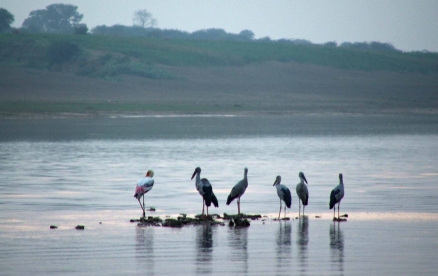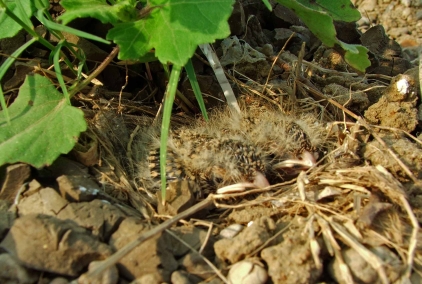It was another such journey. Totally unplanned. As soon as we got to know about the 3 day weekend, the dice were cast. Choice fell on Chambal by sheer accident. And the visit exceeded our wildest expectations.
We set out from Gurgaon early Saturday morning and halted at Dabchick Dhaba near Hodal for a brief snack before proceeding to Agra. By afternoon we reached the Chambal Safari Lodge at Jarar, 62 kilometers from Agra on Fatehabad road. A small signboard beside a dirt track on the right-hand side of the road unobtrusively announced its presence.

The eco-lodge was located within 100 acres of farmland. Vegetables for meals were handpicked from the farm or sourced from the local market. It was open from October to April and organized river safaris, camel safaris, jeep safaris and nature walks inside the Chambal Natioanl Wildlife Sanctuary. We were quickly ushered into our cottage, “Barbet“, upon arrival. The cottage was clean and elegant, furnished in faux pastoral. There were bats on the tree beside it, parrots flitted about and a cluster of babblers furiously hopped about in the ground. Birdcalls filled the air.

The Lodge
The sanctuary was a further 20 Km from the lodge, beyond Bah and Jaitpur. We started by late afternoon and reached the sanctuary gate at Nadgawah in 45 minutes. Except for some congestion at Jaitpur, the drive was comfortable. The asphalt road inside sanctuary stopped short of almost a kilometer from the river. It was possible to take the car through a rutted road all the way to the riverbed risking the strain on shock absorbers. We parked our car where the asphalt road ended and walked rest of the way. The track we followed was flanked by Babul, Khejri and Pipal trees. We spotted Peacocks, Sparrows, Hoopoes, Wagtails, Kingfishers, Jungle Babblers, Barbets and Buzzards along the trail.

From the western embankment where we stood, the shimmering steel grey of the river could be seen for miles. The rustic charm of the place was overwhelming. Beyond the clean shaven riverbank, tilled to plant Sarson and Arhar, the tree line rose up like whiskers. Dry Bajra stalks were piled in several places. A pleasant breeze ruffled our hair. Far away two barges ferried people, motorbikes and bicycles across the banks. The clamour from the barges reached us carried by the wind.

We descended a steep slope and soon reached the safari camp near the shore. Sunil, our naturalist from the lodge had binoculars handy and pointed out several birds to us. We found Sparrow-larks among the bushes. Lapwings, Plovers, Stilts and Greenshanks foraged in the shallow waters. An Osprey hovered over the river, Pied Kingfishers rested on a tree stump midstream, a Cormorant sunned on the bank and a pair of Ruddy Shelducks waddled along the shore.

The lodge had 3 fiberglass boats fitted with outboard motors. Presently they are the only option for anyone interested in river safaris. We clambered into one and impatiently began looking out for Gharials, Muggers and Gangetic River Dolphins.

Soon we picked out two Gharials resting on a sandbank near the shore. As our boat inched near they slithered into the river in panic, their snout and eyes now barely visible above water. We enquired if Gharials ever attacked humans. Negative. They thrived on small fish. Several Gharials rested on the far bank. We cut off the engine and noiselessly drifted near. One had its mouth wide open, exposing an array of razor sharp teeth. Others had their snouts pointing at the sky. They remained motionless, the rhythmic movement of their belly the only sign of life. Yogic trance? Our guide begged to differ. They were warming up before a long night underwater. The Gharials were gregarious. Once we saw at least ten disembodied Gharial snouts and eyes swimming together midstream. They were an endangered species, but appeared oblivious to their fate. We had seen Gharials in captivity before. But watching them here, seeing them swim about freely and sunbathing on the shore we became intensely conscious of the urgent need to preserve this habitat.

The first Mugger crocodile we saw lay camouflaged in mud with its tail dragging in water. As we approached, it slid back into water in reverse gear and swam away. We returned midstream and began looking about for others. Jackals stared at us from the riverside, a kingfisher plunged into water, two Ruddy Shelducks tottered about snorting among the bushes, and a sole Painted Stork stood petrified on a sandbank. Soon we caught sight of another Mugger burrowed deep in mud, merging harmoniously into the landscape. We stopped the engine and edged close. It followed our movement through hooded beige-grey eyes, but remained still. As we watched, two Wooly-necked Storks walked past it, a kingfisher landed on a nearby twig. Muggers seemed solitary compared to Gharials. Did Muggers prey on humans? So far, there have been no such instances, but they were perfectly capable of hurting us. Their cousins, the saltwater crocodiles were bigger, more aggressive and known to attack large animals.

The Holy Grail of our journey, the elusive Gangetic River Dolphin had not appeared yet. We cruised some distance upstream, turned off the engine and began our stakeout. Before long we heard a splash and glimpsed a grey hump disappearing underwater. The dolphin comes up just about every 3 minutes for air. We kept our eyes peeled on the water. Soon a dolphin surfaced and we managed to see the long snout before it went down. Like Gharial, the river dolphin too is critically endangered. Building of dams, deforestation, fishing, pollution and other human activities have rapidly decimated their population. There are only a few hundred of them left. Besides, the dolphins breed only every 3 years, a fact that makes them all the more vulnerable. Hopefully, the status of national fish recently accorded them by the government of India would help in their conservation.

Sun was already marching towards the horizon as we turned back. The placid river had turned a fluid metallic crimson. Some Open-billed Storks were busy scrounging for food on the shore.

As dusk advanced a refreshing cool wind began blowing from south-east. Buffaloes, camels and people were returning home from work. The barges were moored on either bank. As we walked back along the shore we came across a Sparrow-lark nest with two tiny chicks under a small plant. Night had fallen by the time we reached the car.

Dinner at the cottage was sumptuous. We were served mutton cutlets and tomato soup as hors d’œuvre. The main course had chicken flavoured with crushed spices and an array of vegetarian dishes including stuffed tomato, bhindi, arbi, dal and methi aloo. The rotis were served fresh from the oven. Kunwar Ram Pratap Singh, the owner of the lodge joined us during dinner and discussed various environmental issues faced by the sanctuary. 
We set off for the Camel Safari early next morning. Raju and Manisha, the camels assigned for the trip were awaiting us on the riverside. Wooden saddles cushioned with jute sacks and bed sheets were hoisted on their rump and fixed with rope between neck and tail. Once we mounted, the camels rose up tossing us from front to back. I patted Raju on the neck and prayed to almighty God for a safe passage. The ravines unfolded before us. We felt like Bedouins on steroids, out on a sacred quest. Just exaggerating!!.

Ten minutes of rocking and swaying spread-eagled on the camel strained my spine. I kept adjusting my position and finally attained a state of equilibrium least damaging to my pelvis and vertebra. From atop camels we looked down on people and automobiles as they scurried past in billowing dust clouds.

Buffaloes wallowing in fetid pools eyed us curiously. Cows stopped chewing and stared at us. Passing jeeps and motorbikes slowed down to let the camels pass. Pigs scuttled across. Men, women and children paused from their work and straightened up to glare at us. We simultaneously became spectators and spectacles. Some men carried rifles. We enquired if the dacoits were still around. No, they were either dead and buried or transmuted into politicians following the example of Phoolan Devi. The villagers had no more reason to worry. Guns and the elaborate moustaches were mere showoff.

Fourty minutes of camel ride across the ravines took us to Ater fort perched precariously on a hill top. It was built by Bhadauria King Badan Singh, Maha Singh and Bakhat Singh in the era 1664-1668. That was all the information we could gather about the fort from our guide. No one knew its history in detail. The fort was in complete disrepair, there were huge fissures on walls, at some places the bricks looked as if they would fall if you so much as touched them. At the fort entrance Archeological Survey of India had put a warning notice against vandalism. Inside, the wall frescoes were defaced, many had faded away with time, broken stone pillars and brackets cluttered the passages. The only structure intact was the watchtower, but its walls were spoilt by graffiti. Here and there some insouciant restoration work was underway. Pipal saplings and grass shoots protruded from crevices. Some sections were near inaccessible due to overgrown grass and tall shrubs. The decrepitude was almost total. To watch a once magnificent structure being gradually reduced to rubble due to neglect was poignant. 
We took leave of Ater fort by noon. As we left, a flock of pigeons leapt out of its ramparts and swooped back. Buzzards circled over the fort. Nature and time were closing in to seal its fate. We were still pondering over its destiny when the camels deposited us at the riverbank after another spine shattering ride.

The time we spent at the lodge, although brief, was exhilarating. The owners had lent several subtle touches to the lodge and its surroundings which were easy to miss. We complimented them for the excellent taste and hospitality and bid adieu after a leisurely lunch in the open.

The Chambal Ravines
TRAVEL TIPS
CHAMBAL SAFARI LODGE
http://www.chambalsafari.com/
Contact: Kunwar Ram Pratap Singh
Mela Kothi’ Chambal Safari Lodge,
Village and P.O. Jarar,
Bah, District Agra
Tel: +91-94126 51921
Mobile: +91-9837415512
Email: rpsjarar@chambalsafari.com
Distance from Gurgaon to Chambal Safari Lodge – 275 Km
Stopovers along the way – Dabchick Dhaba. Tel 01275-235626, 235555, just after Hodal town. The restaurant is open from 7 AM.
Sikandra, Emperor Akbar’s tomb is on the Delhi-Agra road. Has squeaky clean toilets.
The Agra-Fatehabad road has innumerable bumps. Drive carefully, or else you might end up as a flying projectile.
Bateshwar temple complex is near the lodge. We couldn’t visit it becasuse of the devotee rush during Poornima (full moon).
Agra : Taj Mahal ticket counter opens at 6 AM and closes at 5.30 PM. Prior booking is necessary to visit Taj Mahal during full moon.
Fatehpur Sikri: Beware of guides at Fatehpur Sikri. They flag down vehicles on some pretext and force themselves on the unwary. The best thing to do is to keep the vehicle at the parking lot and take the electric bus to the top. Take a guide only if you think it necessary. Most of them charge exhorbitantly and feed you a lot of bullshit, especially inside the Dargah. Beware of the vendors who coax you into buying the cloth offerings at the Dargah. The rates vary from Rs.250 to Rs.2500. The guides are in collusion with the vendors and inevitably take you to them. Avoid unless you enjoy being fobbed off.
Photo Courtesy Subha Varma, wife and comrade in arms


















